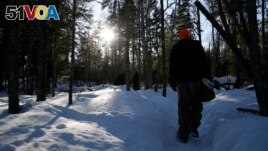31 March 2022
Researchers around the world are trying to find out how much and where COVID-19 is spreading in the wild.
For researcher Todd Kautz and his team that means giving COVID tests to animals like bears, moose, deer and wolves. They are doing their research on a Native American reservation in the north woods of Grand Portage, Minnesota, close to Canada.
Scientists are concerned that the virus could change within animal populations. That could possibly create dangerous new viral mutations that could jump back to humans and spread among people.

Frank Manthey follows E.J. Isaac and Roger Deschampe Jr. into the Grand Portage, Minn. woods on March 2, 2022. (AP Photo/Emma H. Tobin)
The pandemic has shown that the health of humans and animals is closely related. Exactly how the virus started has never been proven. But many scientists say it likely jumped from bats to humans.
Now the virus has been confirmed in wildlife in 24 states in the United States, including Minnesota. Recently, a Canadian study showed someone in nearby Ontario likely got a highly mutated form of the virus from a deer.
"If the virus can establish itself in a wild animal reservoir, it will always be out there with the threat to spill back into the human population," said Matthew Aliota. He is a researcher with the University of Minnesota working with the Grand Portage Reservation team.
E.J. Isaac is a fish and wildlife scientist. He said the risk of the virus mutating grows with the start of spring, when bears wake from hibernation and deer and wolves move to different areas. He said more movement among animals increases the chance of transmission.
Into the wild
The team's research carries its own set of risks.
Sometimes they must capture animals from the air, using a helicopter. They target animals like deer and moose from the air with a net gun. Researchers then test the animal's nose for COVID, and put a tracking device on it.
Another time, Kautz had to enter a bear's den while it was hibernating in order to test it.
After testing the bear, Kautz sent the samples to a lab. He hopes to learn not just which animals are getting infected, but also whether certain animals are more likely to spread the virus to other species.
Looking for mutants
Close contact between humans and animals has permitted the virus to defeat barriers to spread between species.
To infect any living thing, the virus must get into its cells, which is not always easy. Virus expert David O'Connor compares the process to opening a "lock" with the virus' spike protein "key."
"Different species have different-looking locks, and some of those locks" are not going to be openable by the key, the University of Wisconsin-Madison scientist said.
But other locks are similar enough for the virus to enter an animal's cells and make copies of itself. As it does, it can mutate and still have a key that fits in the human lock. That permits it to go back to humans through close contact with live animals, scientists believe.
It is rare for a virus to spread from animals to humans. But it only takes one person to bring a mutated virus to the world of humans. Some scientists think the Omicron variant of the coronavirus came from an animal rather than a human.
What scientists are mostly concerned about is variants spreading widely within a species that comes in contact with humans, like deer.
Scientists found the coronavirus in a third of deer tested in Iowa between September 2020 and January 2021. Other studies found virus antibodies in a third of deer tested in Illinois, Michigan, New York and Pennsylvania.
I'm Dan Novak.
Dan Novak adapted this story for VOA Learning English based on reporting from The Associated Press.
__________________________________________________________________
Words in This Story
mutation — n. a change in the genes of a plant or animal that causes physical characteristics that are different from what is normal
reservoir — n. an extra supply of something
hibernation — n. to spend the winter sleeping or resting
transmission — n. the act or process by which something is spread or passed from one person or thing to another
track — v. to follow and try to find (an animal) by looking for its tracks and other signs that show where it has gone
den — n. the home of some kinds of wild animals
spike protein — n. part of the virus that attaches to human cells
species— n. a group of animals or plants that are similar and can produce young animals or plants
antibody— n. a substance produced by the body to fight disease